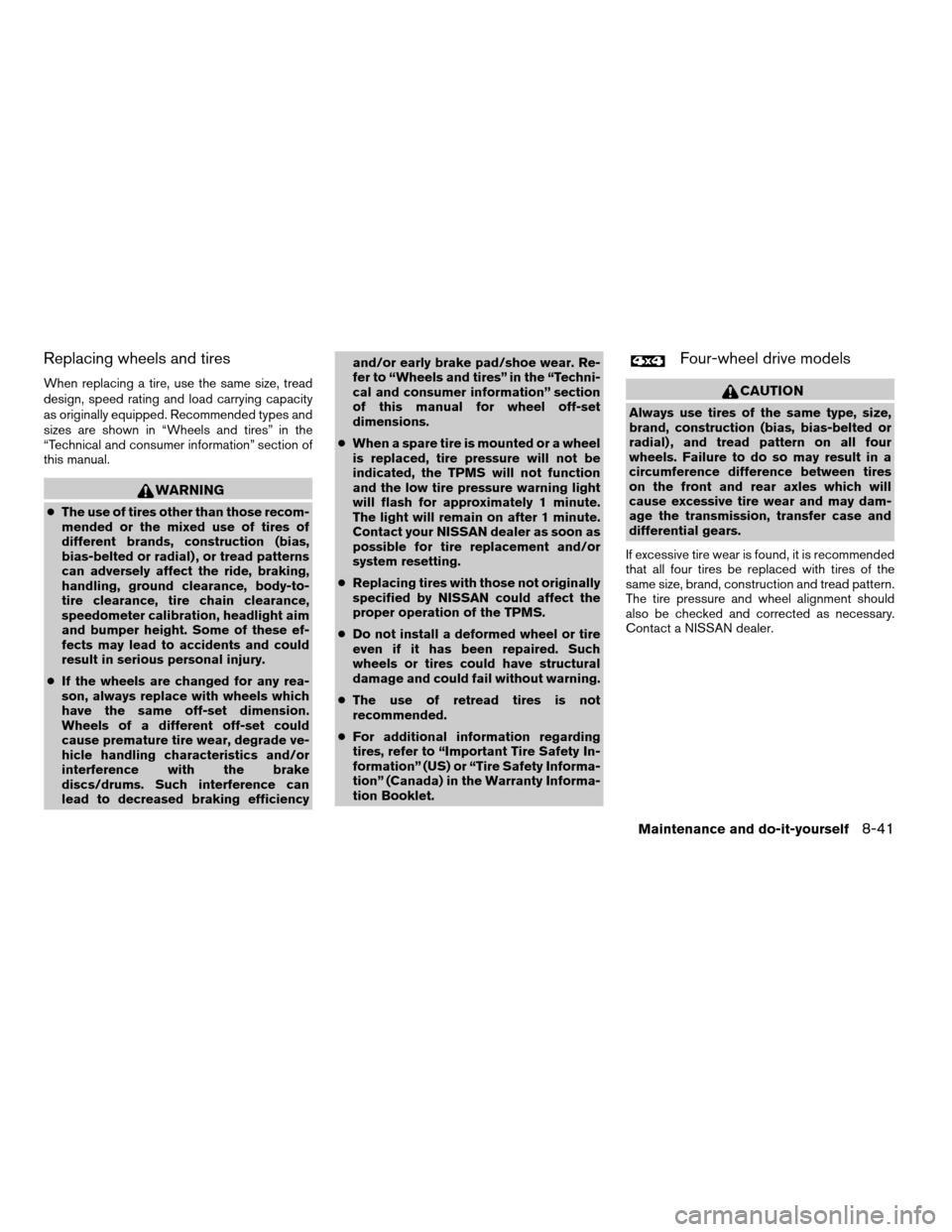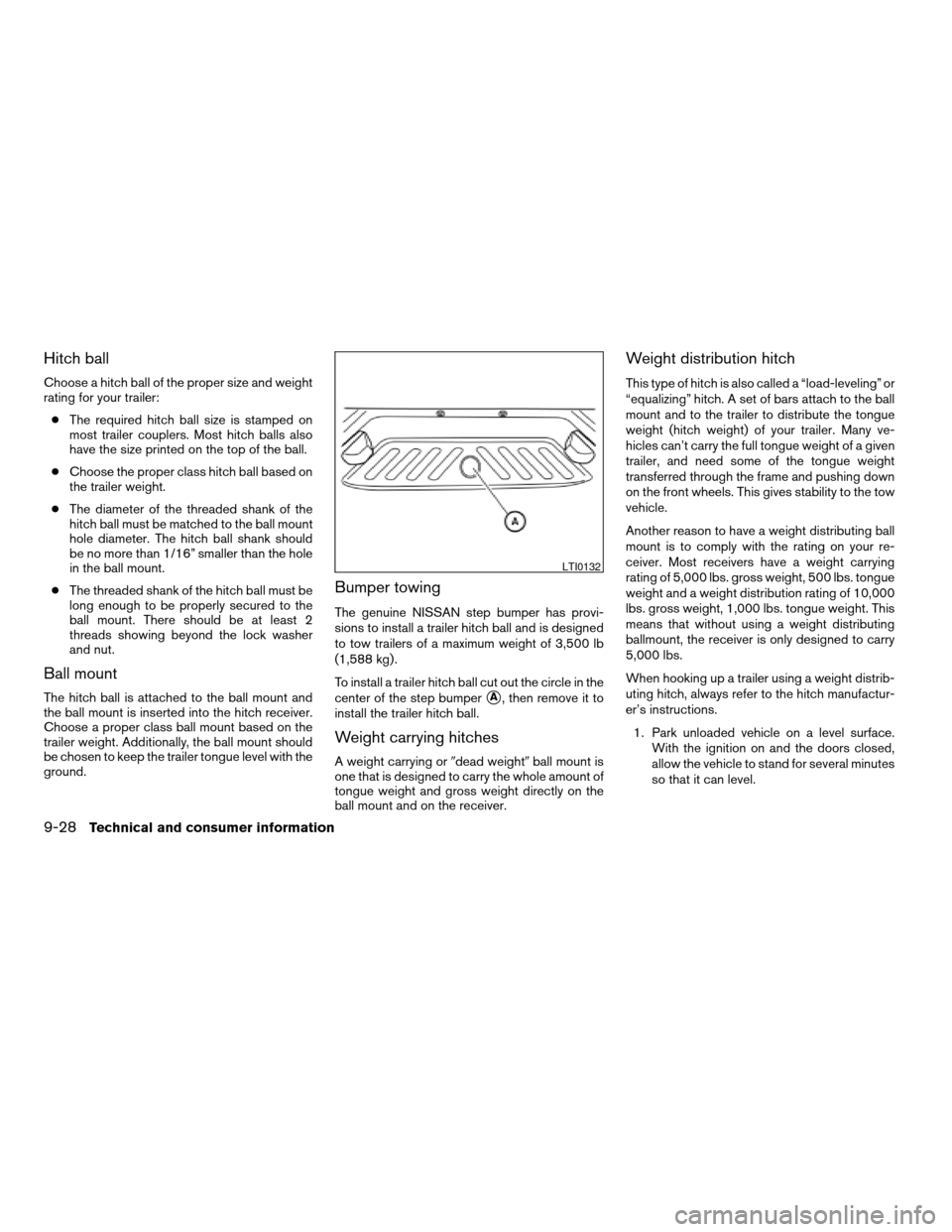2007 NISSAN FRONTIER wheel size
[x] Cancel search: wheel sizePage 287 of 336

Replacing wheels and tires
When replacing a tire, use the same size, tread
design, speed rating and load carrying capacity
as originally equipped. Recommended types and
sizes are shown in “Wheels and tires” in the
“Technical and consumer information” section of
this manual.
WARNING
cThe use of tires other than those recom-
mended or the mixed use of tires of
different brands, construction (bias,
bias-belted or radial) , or tread patterns
can adversely affect the ride, braking,
handling, ground clearance, body-to-
tire clearance, tire chain clearance,
speedometer calibration, headlight aim
and bumper height. Some of these ef-
fects may lead to accidents and could
result in serious personal injury.
cIf the wheels are changed for any rea-
son, always replace with wheels which
have the same off-set dimension.
Wheels of a different off-set could
cause premature tire wear, degrade ve-
hicle handling characteristics and/or
interference with the brake
discs/drums. Such interference can
lead to decreased braking efficiencyand/or early brake pad/shoe wear. Re-
fer to “Wheels and tires” in the “Techni-
cal and consumer information” section
of this manual for wheel off-set
dimensions.
cWhen a spare tire is mounted or a wheel
is replaced, tire pressure will not be
indicated, the TPMS will not function
and the low tire pressure warning light
will flash for approximately 1 minute.
The light will remain on after 1 minute.
Contact your NISSAN dealer as soon as
possible for tire replacement and/or
system resetting.
cReplacing tires with those not originally
specified by NISSAN could affect the
proper operation of the TPMS.
cDo not install a deformed wheel or tire
even if it has been repaired. Such
wheels or tires could have structural
damage and could fail without warning.
cThe use of retread tires is not
recommended.
cFor additional information regarding
tires, refer to “Important Tire Safety In-
formation” (US) or “Tire Safety Informa-
tion” (Canada) in the Warranty Informa-
tion Booklet.
Four-wheel drive models
CAUTION
Always use tires of the same type, size,
brand, construction (bias, bias-belted or
radial) , and tread pattern on all four
wheels. Failure to do so may result in a
circumference difference between tires
on the front and rear axles which will
cause excessive tire wear and may dam-
age the transmission, transfer case and
differential gears.
If excessive tire wear is found, it is recommended
that all four tires be replaced with tires of the
same size, brand, construction and tread pattern.
The tire pressure and wheel alignment should
also be checked and corrected as necessary.
Contact a NISSAN dealer.
Maintenance and do-it-yourself8-41
ZREVIEW COPYÐ2007 Truck/Frontier(d22)
Owners ManualÐUSA_English(nna)
12/13/06Ðcathy
X
Page 296 of 336

WHEELS AND TIRES
Wheels
15 x 7.0J
16 x 7.0J
17 x 7.5J
Tires
P235/75R15
P265/70R16
P265/75R16
P265/65R17
Spare tire Full size
DIMENSIONS AND WEIGHTS
Overall length in (mm) 205.5(5220)
Overall width in (mm) 72.8(1850)
Overall height
With roof rack in (mm) 74.0(1879)
Without roof rack
King cab in (mm) 69.6(1770)
Crew cab in (mm) 70.0(1780)
Front Track
King cab in (mm) 48.2(1225)
Crew cab in (mm) 61.8(1570)
Rear Track
King cab in (mm) 61.8(1570)
Crew cab in (mm) 61.7(1567)
Wheelbase in (mm) 125.9(3200)
Gross vehicle weight
ratinglb (kg)
See the “F.M.V.S.S./C.M.
V.S.S. certification label”
on the center pillar be-
tween the driver’s side
front and side doors. Gross axle weight rating
Front lb (kg)
Rear lb (kg)
9-8Technical and consumer information
ZREVIEW COPYÐ2007 Truck/Frontier(d22)
Owners ManualÐUSA_English(nna)
12/14/06Ðcathy
X
Page 316 of 336

Hitch ball
Choose a hitch ball of the proper size and weight
rating for your trailer:
cThe required hitch ball size is stamped on
most trailer couplers. Most hitch balls also
have the size printed on the top of the ball.
cChoose the proper class hitch ball based on
the trailer weight.
cThe diameter of the threaded shank of the
hitch ball must be matched to the ball mount
hole diameter. The hitch ball shank should
be no more than 1/16” smaller than the hole
in the ball mount.
cThe threaded shank of the hitch ball must be
long enough to be properly secured to the
ball mount. There should be at least 2
threads showing beyond the lock washer
and nut.
Ball mount
The hitch ball is attached to the ball mount and
the ball mount is inserted into the hitch receiver.
Choose a proper class ball mount based on the
trailer weight. Additionally, the ball mount should
be chosen to keep the trailer tongue level with the
ground.
Bumper towing
The genuine NISSAN step bumper has provi-
sions to install a trailer hitch ball and is designed
to tow trailers of a maximum weight of 3,500 lb
(1,588 kg) .
To install a trailer hitch ball cut out the circle in the
center of the step bumper
sA, then remove it to
install the trailer hitch ball.
Weight carrying hitches
A weight carrying or9dead weight9ball mount is
one that is designed to carry the whole amount of
tongue weight and gross weight directly on the
ball mount and on the receiver.
Weight distribution hitch
This type of hitch is also called a “load-leveling” or
“equalizing” hitch. A set of bars attach to the ball
mount and to the trailer to distribute the tongue
weight (hitch weight) of your trailer. Many ve-
hicles can’t carry the full tongue weight of a given
trailer, and need some of the tongue weight
transferred through the frame and pushing down
on the front wheels. This gives stability to the tow
vehicle.
Another reason to have a weight distributing ball
mount is to comply with the rating on your re-
ceiver. Most receivers have a weight carrying
rating of 5,000 lbs. gross weight, 500 lbs. tongue
weight and a weight distribution rating of 10,000
lbs. gross weight, 1,000 lbs. tongue weight. This
means that without using a weight distributing
ballmount, the receiver is only designed to carry
5,000 lbs.
When hooking up a trailer using a weight distrib-
uting hitch, always refer to the hitch manufactur-
er’s instructions.
1. Park unloaded vehicle on a level surface.
With the ignition on and the doors closed,
allow the vehicle to stand for several minutes
so that it can level.
LTI0132
9-28Technical and consumer information
ZREVIEW COPYÐ2007 Truck/Frontier(d22)
Owners ManualÐUSA_English(nna)
12/14/06Ðcathy
X
Page 332 of 336

Turn signal switch..............2-30
Vehicle dynamic control (VDC)
off switch..................2-33
Windshield wiper and washer switch . . .2-26
T
Tachometer....................2-8
Tailgate latch..................3-15
Temperature gauge
Engine coolant temperature gauge.....2-8
Theft (NISSAN vehicle immobilizer system) ,
engine start.............2-25, 3-2, 5-10
Three-way catalyst................5-2
Tie down hooks.................3-17
Tilting steering wheel..............3-11
Tire
Flat tire....................6-2
Spare tire...................6-4
Tire chains..................8-39
Tire placard.................9-11
Tire pressure................8-32
Tire rotation.................8-39
Tires of 4-wheel drive............8-41
Types of tires................8-38
Uniform tire quality grading.........9-34
Wheels and tires..............8-32
Wheel/tire size................9-8
Tire pressure
Low tire pressure warning light......2-17
Tire Pressure Monitoring System (TPMS) . . .5-3
Top tether strap child restraint.........1-24
Towing
2-wheel drive models............6-13
4-wheel drive models............6-14Flat towing..................9-33
Tow truck towing..............6-12
Towing load/specification.........9-27
Trailer towing................9-23
Transceiver
HomeLinkTUniversal Transceiver.....2-52
Transmission
Driving with automatic transmission. . . .5-12
Driving with manual transmission.....5-16
Selector lever lock release.........5-14
Travel (See registering your vehicle
in another country)................9-9
Trip computer...................2-7
Trip odometer...................2-5
Truck - camper loading.............9-22
Turn signal switch................2-30
U
Uniform tire quality grading...........9-34
V
Vanity mirror...................3-12
Vehicle dimensions and weights........9-8
Vehicle dynamic control (VDC) off switch. . .2-33
Vehicle dynamic control (VDC) system. . . .5-32
Vehicle identification...............9-9
Vehicle identification number (VIN)
(Chassis number).................9-9
Vehicle identification number (VIN) plate. . . .9-9
Vehicle loading information...........9-12
Vehicle recovery..............6-15, 7-2
Vehicle security system.............2-23Vehicle security system
(NISSAN vehicle immobilizer system) ,
engine start.............2-25, 3-2, 5-10
Ventilators.....................4-2
Visors......................3-12
Voltmeter....................2-10
W
Warning
4WD warning light.............2-17
Air bag warning light.........1-64, 2-19
Anti-lock brake warning light........2-15
Battery charge warning light........2-16
Brake warning light.............2-16
Door open warning light..........2-16
Engine oil pressure warning light.....2-16
Hazard warning flasher switch.......2-31
Low fuel warning light...........2-17
Low tire pressure warning light......2-17
Low washer fluid warning light.......2-18
Passenger air bag and status light.....1-58
Seat belt warning light...........2-18
Vehicle security system...........2-23
Warning labels (for SRS)..........1-64
Warning/indicator lights and
audible reminders..............2-14
Warning lights..................2-14
Washer switch
Windshield wiper and washer switch . . .2-26
Weights (See dimensions and weights). . . .9-8
Wheels and tires................8-32
Wheel/tire size..................9-8
When traveling or registering your vehicle
in another country................9-9
10-6
ZREVIEW COPYÐ2007 Truck/Frontier(d22)
Owners ManualÐUSA_English(nna)
12/14/06Ðcathy
X